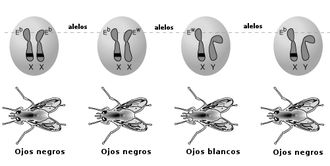Phenotype
In biology and specifically in genetics, the phenotype is the expression of the genotype based on a certain environment. Phenotypic traits include both physical and behavioral traits. It is important to emphasize that the phenotype cannot be defined exclusively as the "visible manifestation" of the genotype, since sometimes the characteristics that are studied are not visible in the individual, as is the case of the presence of an enzyme.
A phenotype is any observable characteristic or trait of an organism, such as its morphology, development, biochemical properties, physiology, and behavior. The difference between genotype and phenotype is that the genotype can be distinguished by looking at the DNA, and the phenotype can be known by observing the external appearance of an organism. Richard Dawkins in his book The Extended Phenotype (1982) has generalized the idea of the phenotype to include heritable characteristics external to the body of the organism, such as the nesting of birds or even the pathological behavior of a parasite. induces in its host.
Etymology
It comes from the Greek phainein, “to appear”, and typhos, “footprint”. Which means the apparent manifestations of the hereditary patrimony of the individual more or less modified by the environment. In another time, as opposed to the genotype, it was defined as the set of non-hereditary characters imprinted on the individual by the environment. Currently, this group is designated by the term peristasis, using the word phenotype only in the aforementioned sense.
Specifications
The phenotype is fundamentally determined by the genotype, or by the identity of the alleles, which, individually, carry one or more positions on the chromosomes. Some phenotypes are determined by multiple genes, and are also influenced by environmental factors. Thus, the identity of one or a few known alleles does not always allow a prediction of the phenotype. In this sense, the interaction between the genotype and the phenotype has been described using the simple equation that is presented below:
In conclusion, the phenotype is any detectable characteristic of an organism (structural, biochemical, physiological or behavioral) determined by an interaction between its genotype and its environment).
The set of phenotypic variability is called polyphasia or polyphenism.
Example
Suppose there is a single gene involved in coding for the pigment that makes up the iris of the human eye. Let us think of two alleles or varieties of said gene: one for brown pigment and another for blue pigment. It is known that if both occur, the expression of the brown pigment (N) is dominant over blue (n), called recessive. Let us also remember that homo sapiens is a diploid species; that is, each parent contributes a complete set of genes so that the individual has two sets. Thus, while for an individual with blue eyes we know that the phenotype and genotype (blue color of the iris, alleles n and n) will be the same, in an individual with dark eyes this Phenotype-genotype correspondence may exist (N and N alleles) or not (N and n alleles), manifesting then the phenotype with the dominant genotypic character (N).
Since phenotypes are much easier to observe than genotypes, classical genetics uses phenotypes to determine gene functions. Breeding experiments can test for these interferences. In this way, early genetic studies are able to trace inheritance patterns without making use of molecular biology.
Contenido relacionado
Noctiluca
Euryarchaeota
Araucariaceae

